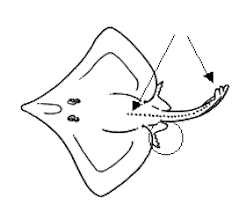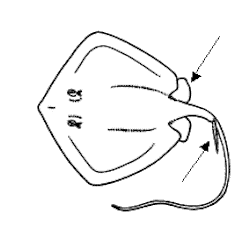Skate or Ray?
Skates and rays can be difficult to differentiate. Both are flat and (with a few notable exceptions, such as the eagle and manta rays) bottom-dwelling elasmobranchs sharing a similar diamond or rhomboid shape. Some of the most familiar forms occur together in coastal habitats. Adding to the confusion, the term 'ray' is also used in reference to the electric and torpedo rays (order Torpediniformes); fortunately, torpedinoids are unlikely to be confused with either skates or rays (especially if one handles a live specimen!), being easily identified by the following characteristics: a rounded pectoral disc; soft, flabby body; dorsal fins nearer the pelvic fins than the tail tip; and kidney-shaped electrogenic organs at the base of the pectoral fins. Distinguishing skates from rays is rather subtle, but once one has learned their respective field marks, it is relatively easy to tell them apart.
Skates (order Rajiformes):
-
 each pelvic fin divided into two lobes
each pelvic fin divided into two lobes - tail relatively stocky, without a stinging spine
-
tail usually with two small dorsal fins near its tip and a tiny caudal fin (some forms lack dorsal and caudal fins)
- many have enlarged, thorn-like scales ('bucklers') along the midline of back and tail; enlarged scales also occur along the side of the body (near the pectoral fin base) in some species
- males have rows of enlarged scales near the eyes and wingtips (termed 'malar' and 'alar' spines, respectively)
Rays (order Myliobatiformes):
-
 each pelvic fin with one lobe
each pelvic fin with one lobe - tail relatively slender to whip-like, usually with a saw-edged stinging spine midway along its length
- tail usually without a dorsal fin (in some forms, a single dorsal fin occurs near the tail base), caudal fin reduced and continuous or absent
- no bucklers along the midline of back or tail (although Hypolophus sephen, sometimes called the 'Pearl Ray', has three rounded scales in the midline of its back) or along the side of the body
- males lack malar or alar spines
In addition, skates are typically drab, brownish or greyish deep-water inhabitants, while many rays are boldly or colorfully patterned, shallow-water inhabitants. But these are generalizations only. Some skates are attractively blotched or spotted and others occur in shallow and even estuarine water, while some rays are plain greyish above, lighter below, and some live at great depths.
